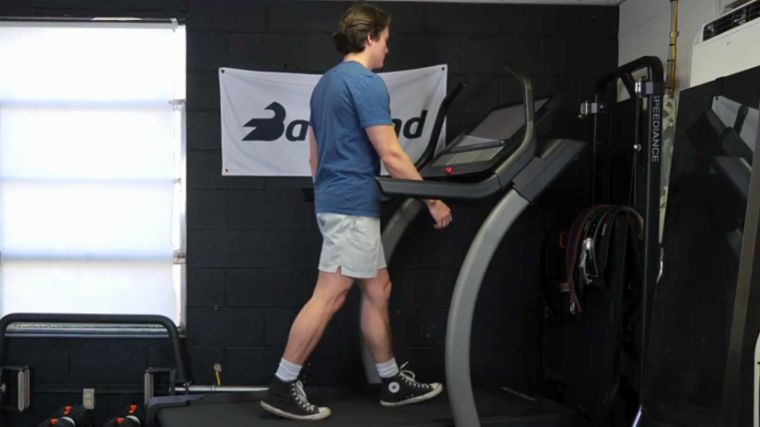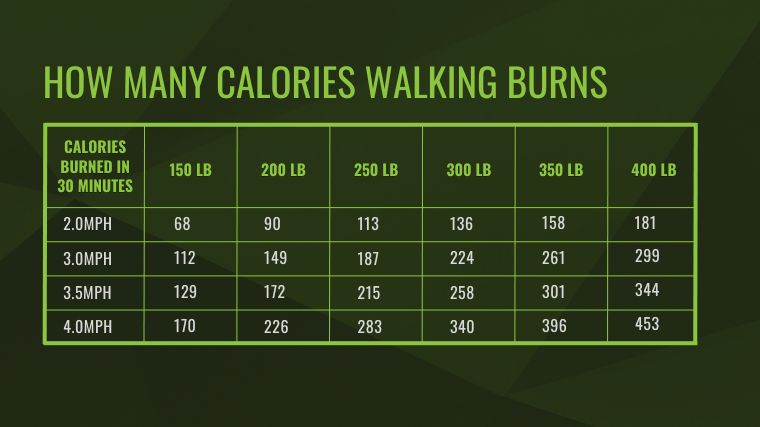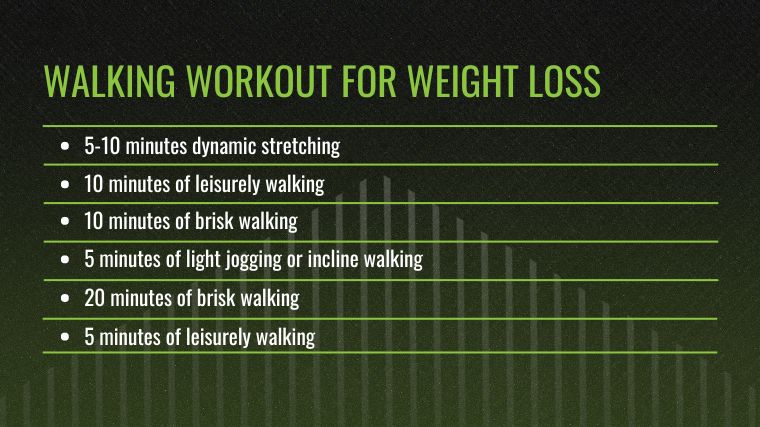[ad_1]
Key Takeaways:
- Walking can lead to weight loss because it burns about 150 calories every 30 minutes.
- To lose weight by walking, aim for a pace of about 3.5 miles per hour in addition to being in a caloric deficit per the American Heart Association (AHA).
- AHA Experts recommend 150 minutes of exercise per week to maintain good health.
- Walking is an efficient way to burn fat; one study showed that women lost 1.5% body fat from walking 3 days per week for 12 weeks.
Weight loss is simple, but that doesn’t mean it’s easy. At its core, any form of exercise will help you lose weight because movement burns calories. This applies to strength training workouts, brisk walking, and everything in-between.


So, if you want to burn fat and change your weight on the scale by upping your activity level through longer walks, you need to know exactly how long, far, and fast you need to be on your daily walk. We’ve got you covered.
How Does Walking Impact Weight Loss?
Walking is a form of physical activity, or locomotion. When it comes to maintaining energy balance (how your body uses or stores the energy you provide it from food), there isn’t much of a difference between walking and, say, weight lifting — they both burn calories. How many calories you burn depends on how hard you work in a given period of time, or how long you keep working, or walking, continuously.
What Is Energy Balance?
Energy balance refers to how your body regulates the fuel you provide it from food. If you’re eating as many calories as you burn, you’re at your “calorie maintenance”, and your weight shouldn’t change too much.
But if you eat in a calorie surplus, or bulk up as bodybuilders often call it, you’ll slowly gain weight depending on how large that surplus is. The same idea holds true for a calorie deficit. One pound of body fat holds roughly 3,500 calories. If you adhere to a 500-calorie daily deficit (created by exercise like walking as well as making smart choices in the kitchen) for a week, you should lose about a pound.
Here’s the best part: You can lose weight by walking, and only walking, as long as your overall activity level is high enough to create what’s called a calorie deficit. Let’s dig into that a little deeper.
How Many Calories Does Walking Burn
Walking from the living room to the bathroom takes a few seconds and probably burns a calorie or two. Running a marathon, on the other hand, burns hundreds if not thousands of calories. Why does this matter? You need to understand, above all, that duration and vigor will directly affect how many calories are burned walking.
[Read More: The Best Leg Exercises and Workouts for Stronger Legs]
Let’s start with a general benchmark. According to physiotherapist and CEO of Advantage Healthcare & Physiotherapy Calum Fraser, a moderately-paced, hour-long walk should burn between 200 and 300 calories for an average-sized person.
That last part is crucial: Larger or heavier individuals carry more body weight, which requires more energy to move from place to place. As a consequence, heavier folk burn more calories walking the same distance as lighter individuals would.
Here’s a visual aid with data from the American Council on Exercise:


If you need help figuring out exactly how many calories you should burn or eat, we’ve got you covered. Try BarBend’s handy calorie calculator:
Benefits of Walking for Weight Loss
We’ll make it simple. Walking burns calories, and if you burn enough calories to create an energy deficit (and then consistently maintain it each day), you’ll lose weight. But that’s just the tip of the iceberg when it comes to the benefits of walking for weight loss. Here are some other factors for you to consider:
Walking Maintains Muscle
Most people will need to engage in some form of resistance training, whether with exercise bands, barbells, dumbbells, or gym machines to build muscle. However, if you’re sedentary, walking makes for a great starting point to build and maintain the muscle mass in your legs.
[Read More: How Many Steps in a Mile? Calculate by Height and Pace]
In fact, a 2018 study published in the European Group for Research Into Elderly and Physical Activity declared that brisk walks, especially for older people, can help slow down muscle loss. (1)
Walking Increases Fat Loss
Aerobic exercise — another way of saying cardio workouts — burns fat. So does strength training, but not everyone has access to a gym. Luckily, you can bet on walking as a sure-fire way of increasing fat oxidation, or the process by which your body pulls on its fat stores to create usable energy.
[Read More: Is Walking Good Cardio?]
A 2022 study showed that seven weeks of a walking workout intervention increased resting fat oxidation in obese subjects, along with several other valuable health metrics like VO2 max. (2)
Walking Is Easy To Maintain
We love group fitness classes as much as anyone, but they don’t always align with our schedule. Similarly, hitting the weights is all well and good until you’ve got a nagging injury or can’t bring yourself to slog through a long commute to the gym after a long day at work.
[Read More: The Best Treadmills for Walking]
Walking comes in clutch here when trying to lose weight. All you need to do to burn calories and lose weight by walking is, well, walk. You can do treadmill workouts or simply step out your door and stroll the block a few times. When it comes to convenience, walking is an unparalleled weight management technique.
Walking Improves Mental Health
You can’t change your body if your brain is in the way. Oftentimes, mental and physical health go hand-in-hand. While nothing is a substitute for true mental healthcare, walking can be incredibly therapeutic in regulating your mood. Studies show that “green walking” outside can have “meaningful implications” on mental health markers. (3)
How to Burn More Calories While Walking
So, here’s where we stand: Walking is physical activity, which burns calories. Burn enough calories to create a calorie deficit — and then sustain it over time — and you’ll lose weight.


[Read More: The Best Treadmill Walking Workouts From a CPT]
Here’s the “problem”. Walking is a low-intensity, slow activity, which means burning lots of calories through a walking workout can take a long time. Not everyone has a full hour to devote to getting their steps in; we sure don’t. So, here are our favorite tips for burning more calories while you walk.
- Try Incline Walking: If you walk on a treadmill, set the grade up a few degrees. Walking uphill takes more energy, so you can burn the same amount of calories in less time. The 12-3-30 workout is a great option here, but remember not to hold onto the frame of the treadmill if you can help it.
- Go Rucking: Rucking is essentially loaded walking. It comes from the military originally, where soldiers need to build up their body conditioning by carrying large rucksacks on their backs. You can load up a backpack with some weight or pick up a weighted vest and try rucking for some extra calorie burn.
- Bring Music (or a Friend): We love peace and quiet, but time can pass slowly if you’re alone with your thoughts. Bring music with you, listen to your favorite podcast, or invite a friend along and you’ll find that a 30-minute walking workout passes in the blink of an eye.
How To Incorporate Walking Into Your Lifestyle
Here are a few other lifestyle-friendly tips for adding walking into your daily routine:
- Go for a walk outside while you drink your morning coffee!
- Take a brisk walk during your lunch break, or between meetings to break up your work day.
- Even better, see if your coworkers would like to go for a walk instead of sitting down for all of your meetings.
- If able, volunteer walking dogs at your local animal shelter.
- For errands that are within walking distance, ditch your car on a nice day and walk to the grocery store or wherever it is you need to go.
Sample Walking Workout for Weight Loss
Walking doesn’t necessarily need to be structured, but it certainly can be. A little bit of structure can help you both lose fat and get fitter, faster. Here’s a simple, straightforward walking workout for weight loss:
The Workout


- 5-10 minutes dynamic stretching
- 10 minutes of leisurely walking
- 10 minutes of brisk walking
- 5 minutes of light jogging or incline walking
- 20 minutes of brisk walking
- 5 minutes of leisurely walking
Equipment Needed: Running shoes or cross-training shoes, weighted vest (optional)
How Often You Should Do This Workout: This workout takes about an hour in total. Start by doing this one three times per week and add additional days as you’re able. You should be able to perform this workout every day of the week!
Modifications
- Make it Easier: If you’re still getting your feet wet with dedicated walking workouts, cut out the 5-minute period of jogging. You can also reduce the 20-minute brisk walk down to 10.
- Make it Harder: Try completing this workout while wearing a weight vest or small backpack to burn more calories.
Takeaways
- Walking helps you lose weight by burning calories.
- The more calories you burn, the larger energy deficit you can create.
- Sustain your calorie deficit for a period of weeks or months by sticking to a walking routine (and following a meal plan or practicing intuitive eating habits) and you’ll begin to lose weight.
- Walking is easy, simple, and accessible to nearly every able-bodied individual.
- You can shave time off your walking workouts by wearing a weight vest, increasing your average walking speed, or walking uphill.
- Walking has been shown to help prevent muscle loss, improve mood, and increase fat oxidation.
Frequently Asked Questions
Can you lose belly fat by walking?
Yes, but it’s not quite that simple. You shouldn’t obsess over spot fat reduction, but know that walking burns fat from all over your body and will eventually target belly fat if you adhere to your exercise routine and maintain a calorie deficit.
How much do I need to walk every day to lose weight?
If walking is your only form of exercise, you’ll need to do a lot of it to lose weight. Many people adhere to a 10,000-step daily benchmark. Try working up to that level while monitoring your body weight and adjust as necessary.
Can I lose weight by walking 30 minutes every day?
Yes! 30 minutes of walking can burn a few hundred calories. In conjunction with regulating your calorie intake and eating healthy, you can create a calorie deficit and lose weight.
How long does it take to see results from walking?
Cardiovascular fitness improves rapidly. You can expect to see positive changes in your fitness and mood after just a week or two of regular walking. If you’re walking solely to lose weight, you’ll have to be more patient and measure your results over a period of months.
References
- Yoshiko A, Tomita A, Ando R, Ogawa M, Kondo S, Saito A, Tanaka NI, Koike T, Oshida Y, Akima H. Effects of 10-week walking and walking with home-based resistance training on muscle quality, muscle size, and physical functional tests in healthy older individuals. Eur Rev Aging Phys Act. 2018 Nov 19;15:13. doi: 10.1186/s11556-018-0201-2. PMID: 30473735; PMCID: PMC6240935.
- Cao J, Lei S, Zhao T, Xie Y, Zhou Z, Cheng S, Wang X. Changes in Fat Oxidation and Body Composition after Combined Exercise Intervention in Sedentary Obese Chinese Adults. J Clin Med. 2022 Feb 18;11(4):1086. doi: 10.3390/jcm11041086. PMID: 35207356; PMCID: PMC8879656.
- Legrand FD, Jeandet P, Beaumont F, Polidori G. Effects of Outdoor Walking on Positive and Negative Affect: Nature Contact Makes a Big Difference. Front Behav Neurosci. 2022 Jun 3;16:901491. doi: 10.3389/fnbeh.2022.901491. PMID: 35726335; PMCID: PMC9206539.
[ad_2]
Source link
Fitnessnacks – #Walking #Lose #Weight #Heres
Courtesy : https://barbend.com/does-walking-help-you-lose-weight/
